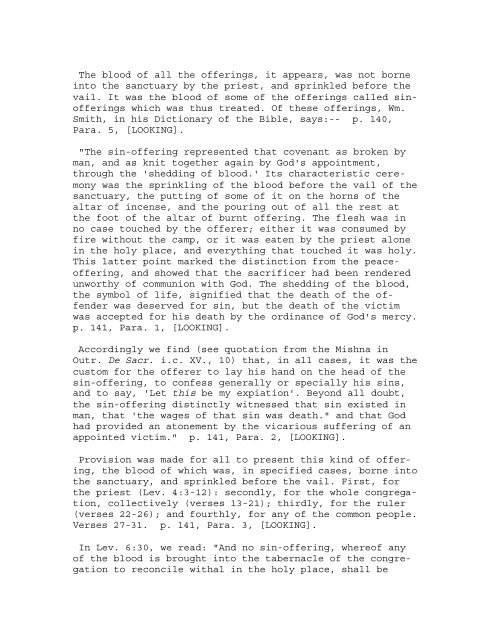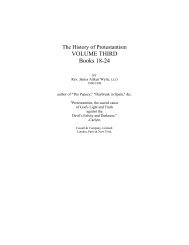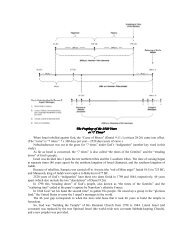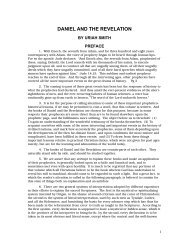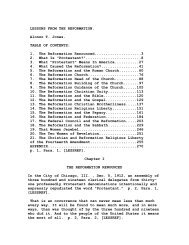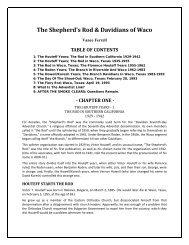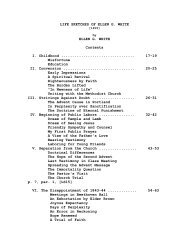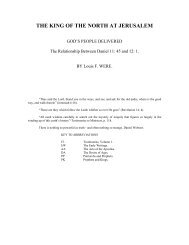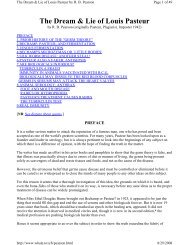LOOKING UNTO JESUS OR CHRIST IN TYPE AND ANTITYPE. BY ...
LOOKING UNTO JESUS OR CHRIST IN TYPE AND ANTITYPE. BY ...
LOOKING UNTO JESUS OR CHRIST IN TYPE AND ANTITYPE. BY ...
Create successful ePaper yourself
Turn your PDF publications into a flip-book with our unique Google optimized e-Paper software.
The blood of all the offerings, it appears, was not borne<br />
into the sanctuary by the priest, and sprinkled before the<br />
vail. It was the blood of some of the offerings called sinofferings<br />
which was thus treated. Of these offerings, Wm.<br />
Smith, in his Dictionary of the Bible, says:-- p. 140,<br />
Para. 5, [<strong>LOOK<strong>IN</strong>G</strong>].<br />
"The sin-offering represented that covenant as broken by<br />
man, and as knit together again by God's appointment,<br />
through the 'shedding of blood.' Its characteristic ceremony<br />
was the sprinkling of the blood before the vail of the<br />
sanctuary, the putting of some of it on the horns of the<br />
altar of incense, and the pouring out of all the rest at<br />
the foot of the altar of burnt offering. The flesh was in<br />
no case touched by the offerer; either it was consumed by<br />
fire without the camp, or it was eaten by the priest alone<br />
in the holy place, and everything that touched it was holy.<br />
This latter point marked the distinction from the peaceoffering,<br />
and showed that the sacrificer had been rendered<br />
unworthy of communion with God. The shedding of the blood,<br />
the symbol of life, signified that the death of the offender<br />
was deserved for sin, but the death of the victim<br />
was accepted for his death by the ordinance of God's mercy.<br />
p. 141, Para. 1, [<strong>LOOK<strong>IN</strong>G</strong>].<br />
Accordingly we find (see quotation from the Mishna in<br />
Outr. De Sacr. i.c. XV., 10) that, in all cases, it was the<br />
custom for the offerer to lay his hand on the head of the<br />
sin-offering, to confess generally or specially his sins,<br />
and to say, 'Let this be my expiation'. Beyond all doubt,<br />
the sin-offering distinctly witnessed that sin existed in<br />
man, that 'the wages of that sin was death." and that God<br />
had provided an atonement by the vicarious suffering of an<br />
appointed victim." p. 141, Para. 2, [<strong>LOOK<strong>IN</strong>G</strong>].<br />
Provision was made for all to present this kind of offering,<br />
the blood of which was, in specified cases, borne into<br />
the sanctuary, and sprinkled before the vail. First, for<br />
the priest (Lev. 4:3-12): secondly, for the whole congregation,<br />
collectively (verses 13-21); thirdly, for the ruler<br />
(verses 22-26); and fourthly, for any of the common people.<br />
Verses 27-31. p. 141, Para. 3, [<strong>LOOK<strong>IN</strong>G</strong>].<br />
In Lev. 6:30, we read: "And no sin-offering, whereof any<br />
of the blood is brought into the tabernacle of the congregation<br />
to reconcile withal in the holy place, shall be


